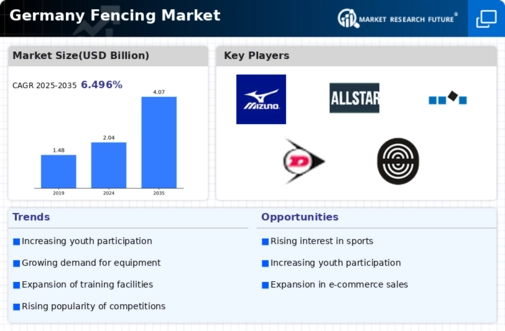Regulatory Standards and Compliance
The fencing market in Germany is also shaped by stringent regulatory standards and compliance requirements. Local and national regulations often dictate the types of materials and designs permissible for fencing installations, particularly in residential areas. This regulatory landscape encourages manufacturers to innovate and produce compliant products that meet safety and aesthetic standards. As a result, the fencing market is likely to see an increase in demand for specialized fencing solutions that adhere to these regulations. Furthermore, the emphasis on quality and safety may lead to higher consumer spending on premium fencing options, thereby influencing market dynamics.
Rising Demand for Security Solutions
The increasing concern for safety and security in residential and commercial properties appears to be a primary driver for the fencing market in Germany. As urbanization continues to rise, property owners are investing in robust fencing solutions to deter intruders and enhance privacy. Recent data indicates that the security fencing segment has experienced a growth rate of approximately 8% annually, reflecting a shift in consumer priorities. This trend is likely to persist as individuals seek to protect their assets and families. The fencing market is thus witnessing a surge in demand for high-quality materials and advanced designs that offer both aesthetic appeal and functional security.
Urban Development and Infrastructure Projects
Germany's ongoing urban development initiatives and infrastructure projects are significantly influencing the fencing market. With the government investing heavily in urban renewal and expansion, there is a growing need for fencing solutions to delineate property boundaries and enhance public spaces. The construction sector has seen a notable increase, with an estimated €50 billion allocated for urban infrastructure in the coming years. This investment is expected to drive demand for various fencing types, including decorative and functional options. Consequently, the fencing market is poised to benefit from these developments, as contractors and developers seek reliable fencing solutions to complement their projects.
Technological Advancements in Fencing Materials
Technological advancements in fencing materials are emerging as a crucial driver for the fencing market in Germany. Innovations such as composite materials and advanced coatings are enhancing the durability and longevity of fencing products. These developments not only improve the performance of fencing solutions but also reduce maintenance costs for consumers. The market is witnessing a shift towards eco-friendly materials, which aligns with the growing consumer preference for sustainable options. As a result, the fencing market is likely to experience increased competition among manufacturers striving to offer cutting-edge products that meet evolving consumer expectations.
Increased DIY Culture and Home Improvement Trends
The rise of the DIY culture and home improvement trends in Germany is significantly impacting the fencing market. More homeowners are opting for self-installation of fencing solutions, driven by the desire for customization and cost savings. This trend is supported by a growing number of online resources and retail platforms that provide fencing materials and installation guides. Recent surveys indicate that approximately 30% of homeowners are likely to undertake fencing projects themselves, which could lead to a shift in purchasing patterns within the fencing market. Consequently, manufacturers may need to adapt their marketing strategies to cater to this emerging consumer segment.
















Leave a Comment